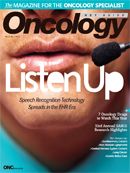Publication
Article
Oncology Live®
Insured Women Are Skipping Mammograms at High Rates
Author(s):
About 40% of insured women in the United States are not undergoing screening mammography at least every 2 years in keeping with guidelines from the USPSTF.

About 40% of insured women in the United States are not undergoing screening mammography at least every 2 years in keeping with guidelines from the US Preventive Services Task Force (USPSTF). Even fewer are getting annual mammograms as recommended by the American Cancer Society (ACS).
"This is cause for concern. All guidelines recommend mammography at a minimum of every 2 years in average-risk healthy women aged 50 to 74. Continued public education and access to mammography are of utmost importance to reaching target goals for breast cancer screening," said lead author Milayna Subar, MD, vice president and national practice leader for Medco Health Solutions in Franklin Lakes, New Jersey, who presented fi ndings from a retrospective study.
USPSTF guidelines, updated in 2009, recommend biennial screenings for women aged 50 to 74 years and individualized decisions on when to start regular screenings for women aged <50 years. The panel does not make recommendations for women aged >75 years. The ACS recommends healthy women undergo annual mammography screenings beginning at age 40.
"After the updated [USPSTF] guidelines were issued, there was a huge outcry, so we decided to conduct a study to determine what women are actually doing regarding mammography screening," Subar said.
Using the Medco Health Solutions database, which contains healthcare records for more than 12 million people with employerprovided insurance or Medicare, Subar and colleagues reviewed medical claims from January 2006 to December 2009 for women aged ≥40 years. They identified >1.5 million women in that age group who had no prior history of breast cancer.
Results were stratified into 4 groups: aged ≥40 years, aged 40 to 49 years, aged 50 to 64 years, and ≥65 years. They were also stratified by year (2006-2009).
In examining broad utilization rates, researchers found women aged 50 to 64 years as a group had the highest rate of adherence to annual mammography screening recommendations, with 54% receiving the test in any given year during the 4-year period. By comparison, 47% of women aged 40 to 49 years and 45% of women aged ≥65 years received an annual mammogram in any given year.
Frequency of Mammography
Age Range
(Years)
Members
Continuously
Eligible
Number of Mammograms Over 4 Years
0
1
2
3
≥4
40 and Older
1,560,299
23%
17%
17%
22%
21%
40-49
406,746
22%
21%
20%
21%
16%
50-64
708,290
19%
16%
18%
24%
23%
65 and Older
445,263
35%
14%
14%
19%
21%
Source: Medco Research Institute. Compliance with mammographic screening guidelines from an administrative claims database. Medco. Medco Health Solutions Inc clinical brief. Published December 9, 2010. Accessed January 18, 2011.
On an individual level, however, the lack of utilization is more dramatic (Table). During the 4-year period, the percentage of women undergoing at least 1 mammogram was only 21% overall, according to Medco Research Institute's clinical brief on the study. (Medco Research Institute).
"These rates are lower than expected, and they need to be addressed," Subar said.
The study did not break down results by education or socioeconomic status, nor did it address the women's reasons for not getting mammograms. Additionally, Subar said other types of screenings, such as physical examinations, were not assessed.
"These data on mammograms are concerning, especially because this study was based on an insured population where cost is not a barrier, and we still have this problem," said Judith Garber, MD, Dana- Farber Cancer Institute, Boston, Massachusetts, who moderated the press conference where the data were released. "Other studies have shown this as well. We've had many reminder programs, and we need to pay attention to the lack of impact of these programs," she added.
The federal government's recently released Healthy People 2010 challenge sets a goal of biennial mammograms for 70% of women aged ≥40, noted the Medco brief. "Clearly, that's not yet been met even among women who have insurance coverage. Continued public education and access to mammography are of utmost importance to reaching these target goals for breast cancer screening," researchers said in the brief.







%20(2)%201-Recovered-Recovered-Recovered-Recovered-Recovered.jpg?fit=crop&auto=format)

%20(2)%201-Recovered-Recovered-Recovered-Recovered-Recovered.jpg?fit=crop&auto=format)
%20(2)%201-Recovered-Recovered-Recovered-Recovered-Recovered.jpg?fit=crop&auto=format)